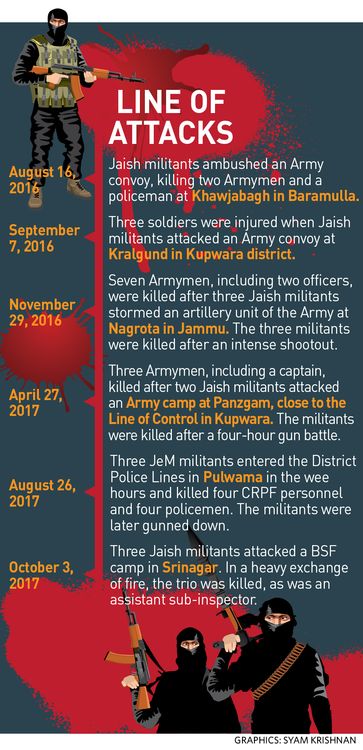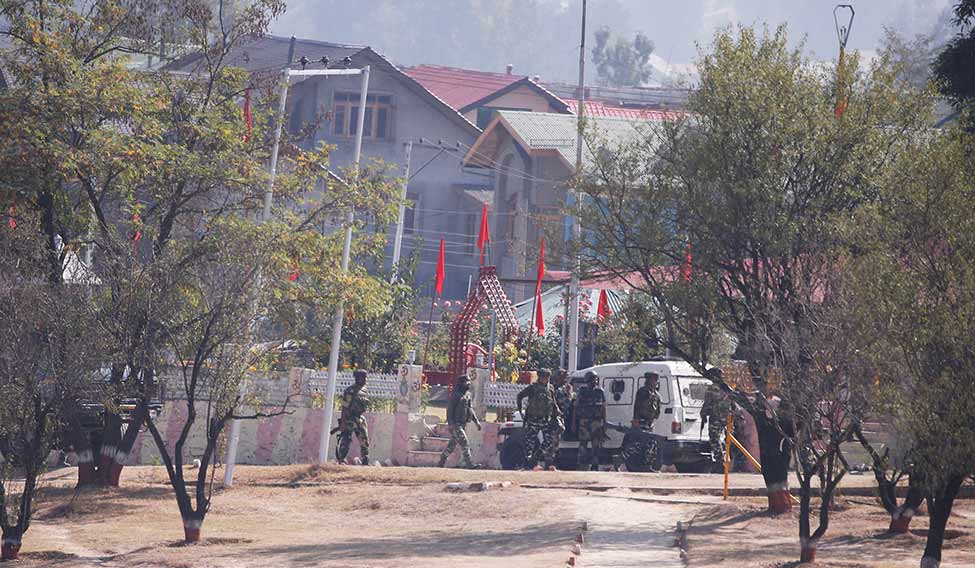This September, the India-Japan joint statement, for the first time, named Pakistan-based Lashkar-e-Taiba and Jaish-e-Mohammed among terrorist organisations. So did the BRICS summit declaration in China. The offensive stance against the organisations is not just on paper, but on ground, too. This year, around 150 militants have been killed by security forces in Jammu and Kashmir. The onslaught has forced Hizbul Mujahideen and Lashkar militants to go into hiding.
But, the Jaish, said security experts, is trying to step up its activities in the state á la the Lashkar, which in the late 1990s launched fidayeen (suicide) attacks on security camps and against the ikhwan (militants who had switched sides and helped the Army hunt down terrorists, especially Hizbul men). The Lashkar’s fidayeen attacks continued till the 1999 Kargil war.
At 4.30am on October 3, three Jaish fidayeen, two of them in Army uniform, attacked the high-security 182 battalion headquarters of the Border Security Force, adjacent to the Indian Air Force base, part of which is used as Srinagar airport. The trio entered the camp after cutting the barbed fence separating the two neighbouring civilian colonies. On being spotted, they opened fire and launched grenades, injuring three BSF men. The IAF quickly relocated its fighter planes, before the BSF, the CRPF and the police “neutralised” the fidayeen in a joint operation. An assistant sub-inspector, too, was killed in the heavy firing. Inspector General of Police Muneer Khan said: “The fidayeen belonged to Jaish-e-Muhammad and seven other members of the group are on the prowl, and could launch further attacks.”

The Jaish fidayeen, sources said, were part of a 25-member group that had entered Poonch from Pakistan-occupied Kashmir in September. They call themselves the Afzal Guru Squad (AGS). This was the second major attack by the AGS in recent months. On August 26, three Jaish fidayeen raided the district police lines in Pulwama, and killed four CRPF men and four policemen. They were later shot dead. “We are maintaining pressure on the militants, and have killed many top commanders. Jaish is trying to release some pressure,” Director General of Police S.P. Vaid told THE WEEK.
The Jaish has stepped in at a time when the morale of the militants is low. Four of the 11 most wanted militants were killed this year—Lashkar’s Bashir Ahmed Wani, Abu Dujana, a Pakistani national (both category A++), Junaid Ahmed Matoo alias Kandroo and Hizbul’s Muhammad Yasin Ittoo (both category A). The remaining seven are Lashkar’s Zeenat-ul-Islam alias Alkama, Showkat Ahmed Tak alias Huzaifa, Hizbul’s Wasim Ahmed alias Osama, Riyaz Ahmed Naikoo alias Zubair, Altaf Ahmed Dar alias Kachroo, Jaish’s Abu Hamas, resident of Pakistan, and Zakir Musa, who broke ranks with Hizbul and joined an Al Qaeda affiliate.
Most militants have gone into hiding and shunned the use of cellphones that helped track them down. But, IGP Khan said the police would still get them. “In the 1990s, there were successful anti-militancy operations and there were no mobiles then.”
The Parliament attack in 2002 was allegedly masterminded by Jaish chief Maulana Masood Azhar, who is in Pakistan. However, Jaish could not revive itself in Kashmir after its top leadership was wiped out in an operation in Kupwara in 2004. “The Jaish always wanted to emerge stronger in Kashmir, but Pakistan prefers Lashkar over it,” said an official. The Lashkar is largely Punjabi and wants Kashmir’s integration with Pakistan, but Jaish is Islamist and draws cadres from other ethnicities in Pakistan. But now, Pakistan has allowed Jaish to operate more freely.
The first major sign of Jaish’s revival in Kashmir emerged in November 2015, when the Army foiled a fidayeen attack on battalion headquarters in Kupwara. Three militants—Hussian, Muawia and Rizwan— were killed, while the fourth, Sadiq Gujjar, a resident of Sialkot in Pakistani Punjab, managed to escape. Gujjar hid in the forests for several weeks and later befriended a computer operator, who made fake Aadhaar and election cards for him. He also put Gujjar in touch with five youths in Baramulla, who roped in a policeman’s son. For a while, Gujjar stayed at the subsidiary training centre in Sheeri, where the policeman was posted, to avoid detection. After his arrest in February, he told interrogators that his group was sent to revive the Jaish in north Kashmir, and that he got training from Gori Fazal Shah, a senior Jaish member, at the Syed Shah Ismail Shaheed Madrassa in Kashmir.
After Gujjar’s arrest, the Jaish sent another group of six members. They, too, stayed in the forests for a few weeks and then split into smaller groups. Abdul Rehman, who was part of the group, was nabbed by security forces from Baramulla on May 15. “After Gujjar’s arrest, there was a vacuum in Baramulla,” said Major General J.S. Nian, general officer commanding of Baramulla-based Army division, during a briefing. “He [Rehman] told us that he was tasked to recruit people for suicide attacks in Kashmir.” Nine days after Rehman’s arrest, the police killed two suspected Jaish militants in Srinagar.
The Jaish has also attacked vital security installations outside Kashmir, including the Pathankot air base in Punjab last January. But, security forces are on their toes, too.







